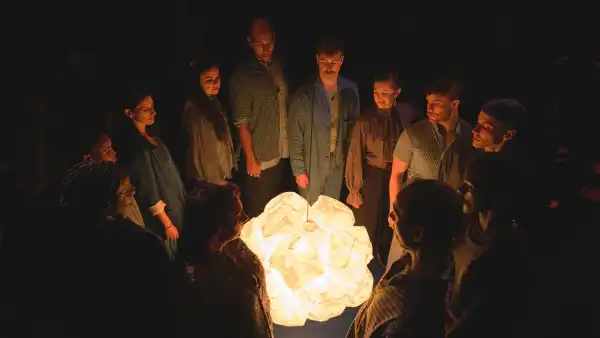
Save this storySave this storySave this storySave this story
The previous instance of composer Heather Christian’s “Oratorio for Living Things” on a New York stage occurred in the spring of 2022, a period when communal gatherings still carried a sense of daring. Some of us had awaited it for years: Ars Nova initially intended to present “Oratorio,” a sung-through musical piece, partially in Latin, that addresses the “sacred” concept of time, at Greenwich House in 2020. However, the onset of the pandemic caused its closure. Two years subsequently, Christian’s creation for twelve voices was revived, with the protracted delay seemingly having honed it to a sharp intensity. During that initial tentative period post-lockdown, “Oratorio” was presented in intentionally intimate surroundings, with attendees tightly packed on stage in an oval of tiered seating, as the ensemble, adorned in blue, ascended the levels to perform before, above, behind, and alongside them. The production was sublime—a remarkable, quasi-religious, non-narrative, partially Latin popular item—but, following several cast members contracting COVID, Ars Nova was compelled to cancel the concluding week of shows.
Now, the exquisite “Oratorio” has been resurrected, this time at the Signature. Lee Sunday Evans is once again at the helm, much of the initial company (including a smaller band) has reprised their roles, and Krit Robinson’s wooden oval has returned, albeit in a somewhat larger iteration. The multi-layered area, again bathed in a profound indigo hue by lighting designer Jeanette Oi-Suk Yew, evokes a ship’s hull, or perhaps an operating room at dusk. At the center of this shadowy azure space—Christian, in discussion, describes blue as representing “deep time”—Robinson suspends an odd illuminant, a swollen paper lantern resembling a piece of popcorn yet radiating like the sun, or perhaps the core of a magnified particle.
Unless your Latin comprehension is exceptional, the initial segment of “Oratorio” may be perplexing. Nonetheless, as you concentrate, patterns materialize, followed by a sudden surge of understanding as the vocalists transition to English. Just prior to this revival’s debut, Christian was awarded a MacArthur Fellowship for “cultivating space for contemplation of the sacred.” Her discourse herein centers on the relentless progression of time, consequently, the lyrics occasionally depict natural occurrences, such as the cyclical movement of water between surface and atmosphere, or the duration we devote to specific commonplace activities in a lifetime: “ten minutes providing faulty directions to strangers”; “nine days awaiting a response.” An assemblage of early recollections, a reflection on decomposition, swirling constellations—each verse contends with transformation on a personal or cosmic level. A particular solo passage, delivered with a delicate, worn tone by Dito van Reigersberg, portrays hydrogen and helium as parental figures whose tumultuous interactions engender everything in existence.
Christian’s composition incorporates numerous genres linked to ritual, whether sacred or secular. Within her intricate, fugal frameworks, echoes of solemn liturgical chants, Quaker plainchants, Steve Reich’s “Clapping Music,” Carl Orff’s “Carmina Burana” (alongside his pedagogical adaptations), and an exuberant Baptist chorus can be discerned. She has long held an interest in repetition and recursion—her musical interpretation of Gertrude Stein’s “The World Is Round” (“Rose is a Rose is a Rose”) garnered an Obie in 2014, and she contributed the music for a video piece during the shutdown era, “I Am Sending You the Sacred Face,” in which she voiced all parts, utilizing loops to harmonize with herself. When Christian vocalizes, her timbre reverberates with a mournful, blues-tinged inflection. However, her compositions for others possess a more pressing quality than a somber one. Frequently, an escalating, complex melody will coalesce into a solitary, persistent note; tempos escalate and accelerate anew; her performers relinquish words to emit sounds akin to sirens. The initial hour of “Oratorio” wields an astonishing potency. Overcome, I perceived myself as the striker within a massive, resonating bell.
Therefore, why did “Oratorio” ultimately instill in me a sense of melancholy? Repetition, Christian imparts, serves as both a gauge and a generator of meaning, and throughout “Oratorio” I became preoccupied with the minute distinctions between this staging and the earlier, seemingly identical one from 2022. (For everything there is a season, and perhaps the pandemic, strangely, benefited “Oratorio.”) Evans has, once again, instructed the cast to grin frequently, to maintain visual communication with us as they perform. Three years prior, this rendered them akin to fellow attendees extending greetings across the aisles, yet a modification has transpired—perhaps our heightened awareness of crisis, perhaps their increased refinement—and that polished affability can appear somewhat saccharine. As the production progresses beyond its magnificent opening hour, the concluding thirty minutes tend toward the overly sentimental. “If you’re here, you have to change,” someone intones, and at that juncture, it resonated more akin to Sunday school rather than a religious service.
Christian has long been captivated by the church clock, and she has authored several compositions commemorating the ancient canonical hours, including the remarkable “Terce,” from 2024, intended for performance at nine in the morning, and the streamable “Prime,” best experienced at 6 A.M. Adhering to the breviary’s structure, I posit that “Oratorio” warrants periodic revivals; each iteration will inevitably transform it anew. Even at present, I find myself contemplating the show’s astounding commencement, which is somehow eclipsing my recollection of the less satisfying conclusion. Time advances ceaselessly, Christian’s text proclaims, representing her interpretation of good tidings. “We are in the middle,” Christian assures us. “We aren’t at the end / of a loop.”
A distinct type of pseudo-church offering unfolds within “Oh Happy Day!,” Jordan E. Cooper’s own scripturally influenced work, currently staged downtown at the Public. This production, frustrating yet sporadically captivating, directed by Stevie Walker-Webb, functions as a personal devotion—a simultaneous immersion, return, and elevation for Cooper himself.
The playwright and actor, a Tony nominee for “Ain’t No Mo’ ” two seasons prior, embodies Keyshawn, an individual returning home under compulsion: in truth, he has recently died, but his essence must fulfill a task before reaching his reward. Abandoned as a teen, long disregarded by his homophobic father (Brian D. Coats), and alienated from his sister, Niecy (Tamika Lawrence), and her offspring, Kevin (Donovan Louis Bazemore), Keyshawn has been divinely tasked with somehow saving them all from an impending flood (signified by the capital F), poised to engulf their locality in Laurel, Mississippi. Naturally, Keyshawn is enraged that God intends him to set aside his legitimate grievances to rescue his kin. Why did his father never seek him out, particularly upon learning Keyshawn resorted to sex work for survival? However, God, manifested as each of Keyshawn’s family members, refuses to accept “no” as an answer.
The show is narrated by three celestial “Divines” (Tiffany Mann, Sheléa Melody McDonald, and Latrice Pace), attired in shimmering violet gowns. (Qween Jean conceived the costumes, some of which, humorously, illuminate.) The Divines uplift Keyshawn’s spirits by performing numerous fresh compositions penned by gospel composer Donald Lawrence, who adeptly interweaves theatrical language into his lyrics. “If you want to change what you’re seeing . . . reset!” the Divines proclaim, as resplendent as the trumpets at Jericho, while Keyshawn rearranges the set pieces—such as a chair he has just hurled across the space—to reattempt a particular family interaction. The play similarly reiterates its gestures, sometimes tediously: Keyshawn incessantly hurls himself against his family’s indifference, whereupon a vision of God admonishes him. The objective is Keyshawn’s eventual emotional collapse. Fortunately, the music sustains the rest of us, upward, upward, upward.
It’s notable that an abundance of theatre-transformed-into-church material has emerged this fall. New York Theatre Workshop recently presented “Saturday Church,” a Sia musical featuring a queer ballroom rendition of a service, where J. Harrison Ghee presides as Black Jesus and the dancers frequently shed their choral attire; Playwrights Horizons recently unveiled Jen Tullock’s solo play “No One Can Take You from the Hand of God,” concerning a woman who abandons her oppressive religious upbringing only to concede that she yearns for her faith. And at Ars Nova, the radiant “pastor’s kid” writer-performer Brandon Kyle Goodman serves as both a preacher and a joyful sex-educator (envision a Mr. Rogers who dons both a cardigan and fetish accessories) in the deliriously sex-affirming “Heaux Church.” Their gospel incorporates cheerful educational interludes by puppet genitalia—Floppy, the purple penis, contends with feelings of shame—and extensive audience participation, encompassing hands-and-tongues-on instruction employing glazed confections.
One cannot swing a censer in this city currently without encountering someone who, although raised within the Christian tradition, feels excluded from its conventional services. It is hardly coincidental that numerous such projects explicitly reclaim its queer structures and decorations, all while recognizing the value of its musical heritage. (One joyous sound can resemble another.) We are demonstrably in an era marked by intense spiritual searching, and it is noteworthy that numerous individuals have discovered answers within the theatre. In “Oh Happy Day!,” Keyshawn struggles to envision where he will procure the resources for an ark until he recognizes the ease of deconstructing his father’s dwelling. The lumber for a novel construction lies before him; he merely needs to dismantle the existing structure and erect something new. ♦
Sourse: newyorker.com







